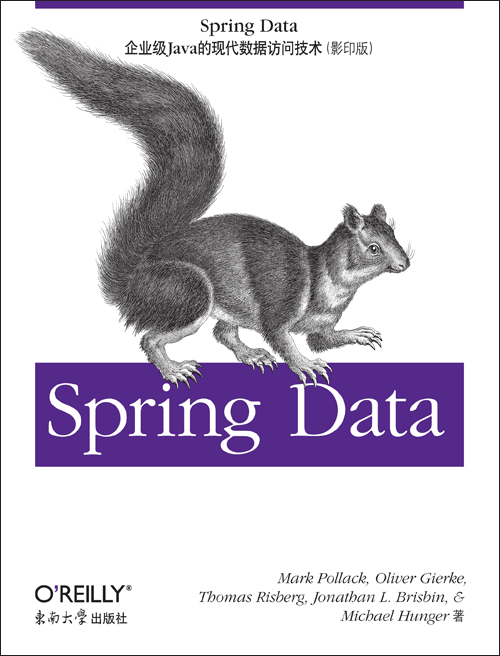Spring Data(影印版)
出版时间:2013年06月
页数:288
“你将对如下内容有深刻的理解:为什么现代的数据访问变得越来越专业化和分门别类,NoSQL数据存储的主要分类,Spring Data如何帮助Java开发人员在当前新环境下有效地开发。”
——Rod Johnson
Spring框架的开创者
“通过使用Spring Batch和Spring Data,我们将能够彻底地简化和减少与Hadoop交互时的复杂性,同时还能提供可靠性。”
——David Gevorkyan
eHarmony公司的软件工程师
在使用关系型数据库搭建Java企业应用时,你可以选择多种数据访问框架。但是在处理大数据的时候呢?这本包含丰富实践的指南将为你展示Spring Data如何使得搭建基于诸如NoSQL和Hadoop这样一些新型数据访问技术的应用变得更加简单。
通过多个示例项目,你将了解到Spring Data如何提供了一个兼容NoSQL特有特性和功能的编程模型,以及它如何帮助你开发基于诸如数据分析、事件流处理和工作流之类用例的Hadoop应用。你也将找到那些Spring Data添加到Spring现有JPA和JDBC中的特性,它们用来实现基于RDBMS的数据访问层。
· 学习有关Spring的模板辅助类,它能够简化数据库特有功能的使用
· 探讨Spring Data的抽象资源库和先进的查询功能
· 在Redis(键/值存储)、HBase(列族)、MongoDB(文档数据库)和Neo4j(图像数据库)中运用Spring Data
· 寻找GemFire分布式数据的网格解决方案
· 把Spring Data JPA的管理实体作为RESTful web服务导出到Web中
· 使用轻量级的对象映射框架来简化HBase应用的开发
· 使用Spring Batch和Spring Integration来搭建大数据管道的样例
——Rod Johnson
Spring框架的开创者
“通过使用Spring Batch和Spring Data,我们将能够彻底地简化和减少与Hadoop交互时的复杂性,同时还能提供可靠性。”
——David Gevorkyan
eHarmony公司的软件工程师
在使用关系型数据库搭建Java企业应用时,你可以选择多种数据访问框架。但是在处理大数据的时候呢?这本包含丰富实践的指南将为你展示Spring Data如何使得搭建基于诸如NoSQL和Hadoop这样一些新型数据访问技术的应用变得更加简单。
通过多个示例项目,你将了解到Spring Data如何提供了一个兼容NoSQL特有特性和功能的编程模型,以及它如何帮助你开发基于诸如数据分析、事件流处理和工作流之类用例的Hadoop应用。你也将找到那些Spring Data添加到Spring现有JPA和JDBC中的特性,它们用来实现基于RDBMS的数据访问层。
· 学习有关Spring的模板辅助类,它能够简化数据库特有功能的使用
· 探讨Spring Data的抽象资源库和先进的查询功能
· 在Redis(键/值存储)、HBase(列族)、MongoDB(文档数据库)和Neo4j(图像数据库)中运用Spring Data
· 寻找GemFire分布式数据的网格解决方案
· 把Spring Data JPA的管理实体作为RESTful web服务导出到Web中
· 使用轻量级的对象映射框架来简化HBase应用的开发
· 使用Spring Batch和Spring Integration来搭建大数据管道的样例
- Chapter 1: The Spring Data Project
- NoSQL Data Access for Spring Developers
- General Themes
- The Domain
- The Sample Code
- Chapter 2: Repositories: Convenient Data Access Layers
- Quick Start
- Defining Query Methods
- Defining Repositories
- IDE Integration
- Chapter 3: Type-Safe Querying Using Querydsl
- Introduction to Querydsl
- Generating the Query Metamodel
- Integration with Spring Data Repositories
- Relational Databases
- Chapter 4: JPA Repositories
- The Sample Project
- The Traditional Approach
- Bootstrapping the Sample Code
- Using Spring Data Repositories
- Chapter 5: Type-Safe JDBC Programming with Querydsl SQL
- The Sample Project and Setup
- The QueryDslJdbcTemplate
- Executing Queries
- Insert, Update, and Delete Operations
- NoSQL
- Chapter 6: MongoDB: A Document Store
- MongoDB in a Nutshell
- Setting Up the Infrastructure Using the Spring Namespace
- The Mapping Subsystem
- MongoTemplate
- Mongo Repositories
- Chapter 7: Neo4j: A Graph Database
- Graph Databases
- Neo4j
- Spring Data Neo4j Overview
- Modeling the Domain as a Graph
- Persisting Domain Objects with Spring Data Neo4j
- Combining Graph and Repository Power
- Advanced Graph Use Cases in the Example Domain
- Transactions, Entity Life Cycle, and Fetch Strategies
- Advanced Mapping Mode
- Working with Neo4j Server
- Continuing From Here
- Chapter 8: Redis: A Key/Value Store
- Redis in a Nutshell
- Connecting to Redis
- Object Conversion
- Object Mapping
- Atomic Counters
- Pub/Sub Functionality
- Using Spring’s Cache Abstraction with Redis
- Rapid Application Development
- Chapter 9: Persistence Layers with Spring Roo
- A Brief Introduction to Roo
- Roo’s Persistence Layers
- Quick Start
- A Spring Roo JPA Repository Example
- A Spring Roo MongoDB Repository Example
- Chapter 10: REST Repository Exporter
- The Sample Project
- Big Data
- Chapter 11: Spring for Apache Hadoop
- Challenges Developing with Hadoop
- Hello World
- Hello World Revealed
- Hello World Using Spring for Apache Hadoop
- Scripting HDFS on the JVM
- Combining HDFS Scripting and Job Submission
- Job Scheduling
- Chapter 12: Analyzing Data with Hadoop
- Using Hive
- Using Pig
- Using HBase
- Chapter 13: Creating Big Data Pipelines with Spring Batch and Spring Integration
- Collecting and Loading Data into HDFS
- Hadoop Workflows
- Exporting Data from HDFS
- Collecting and Loading Data into Splunk
- Data Grids
- Chapter 14: GemFire: A Distributed Data Grid
- GemFire in a Nutshell
- Caches and Regions
- How to Get GemFire
- Configuring GemFire with the Spring XML Namespace
- Data Access with GemfireTemplate
- Repository Usage
- Continuous Query Support
- Bibliography
书名:Spring Data(影印版)
国内出版社:东南大学出版社
出版时间:2013年06月
页数:288
书号:978-7-5641-4200-1
原版书书名:Spring Data
原版书出版商:O'Reilly Media
The animal on the cover of Spring Data is the giant squirrel (genus Ratufa), which is the largest squirrel in the world. These squirrels are found throughout tropical Asiatic forests and have a conspicuous two-toned color scheme with a distinctive white spot between the ears. Adult head and body length varies around 14 inches and the tail length is approximately 2 feet. Their ears are round and they have pronounced paws used for gripping.
A healthy adult weighs in at around four and a half pounds. With their tan, rust, brown, or beige coloring, they are possibly the most colorful of the 280 squirrel species. They are herbivorous, surviving on flowers, fruits, eggs, insects, and even bark.
The giant squirrel is an upper-canopy dwelling species, which rarely leaves the trees, and requires high branches for the construction of nests. It travels from tree to tree with jumps of up to 20 feet. When in danger, the giant squirrel often freezes or flattens itself against the tree trunk, instead of fleeing. Its main predators are birds of prey and leopards. The giant squirrel is mostly active in the early hours of the morning and in the evening, resting in the midday. It is a shy, wary animal and not easy to discover.
A healthy adult weighs in at around four and a half pounds. With their tan, rust, brown, or beige coloring, they are possibly the most colorful of the 280 squirrel species. They are herbivorous, surviving on flowers, fruits, eggs, insects, and even bark.
The giant squirrel is an upper-canopy dwelling species, which rarely leaves the trees, and requires high branches for the construction of nests. It travels from tree to tree with jumps of up to 20 feet. When in danger, the giant squirrel often freezes or flattens itself against the tree trunk, instead of fleeing. Its main predators are birds of prey and leopards. The giant squirrel is mostly active in the early hours of the morning and in the evening, resting in the midday. It is a shy, wary animal and not easy to discover.
购买选项
